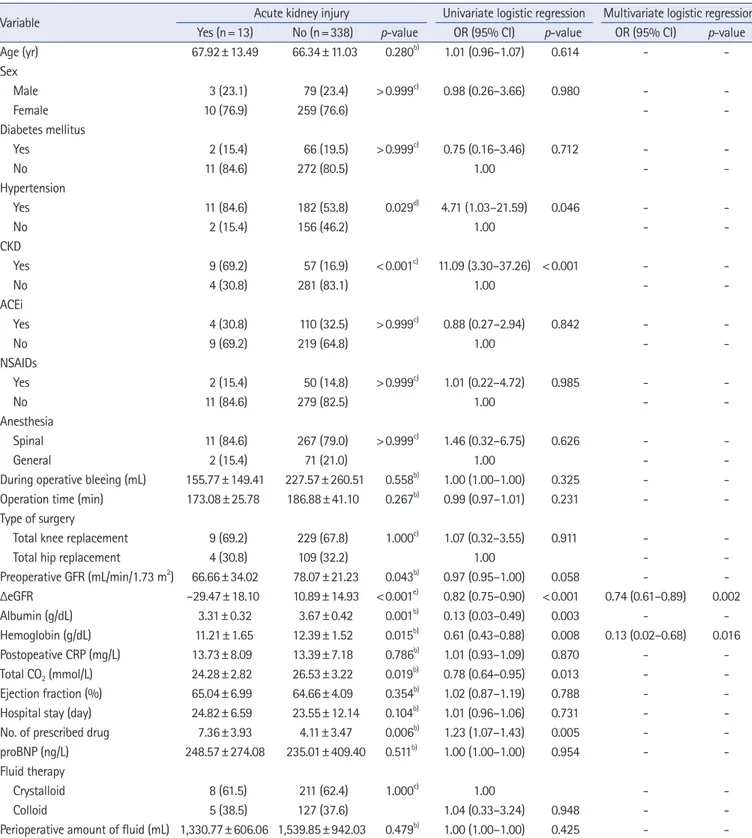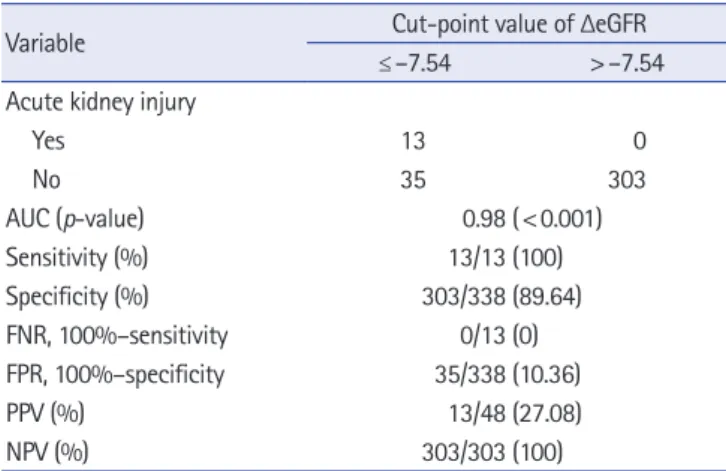Introduction
Postoperative acute kidney injury (AKI), which increases the risk of postoperative morbidity and mortality, poses a major concern to surgeons [1,2]. Previous studies reported a 9.1% risk of AKI after elective or emergency orthopedic surgical procedures [3,4].
According to a study conducted in patients who underwent any type of inpatient operative procedure in the United States, hospi- tal mortality showed a high correlation with postoperative AKI.
In patients with AKI, the lengths of stays in the intensive care
Analysis of the risk factors of acute kidney injury after total hip or knee replacement surgery
Yoo Jin Lee, Bong Soo Park, Sihyung Park, Jin Han Park, Il Hwan Kim, Junghae Ko, Yang Wook Kim
Department of Internal Medicine, Inje University Haeundae Paik Hospital, Inje University College of Medicine, Busan, Korea
Background: Postoperative acute kidney injury (AKI), which increases the risk of postoperative morbidity and mortality, poses a major concern to surgeons. We conducted this study to analyze the risk factors associated with the occurrence of AKI after orthopedic surgery.
Methods: This was a retrospective study that included 351 patients who underwent total hip or knee replacement surgery at Inje University Haeundae Paik Hospital between January 2012 and December 2016.
Results: AKI occurred in 13 (3.7%) of the 351 patients. The patients’ preoperative estimated glo- merular filtration rate (eGFR) was 66.66 ± 34.02 mL/min/1.73 m
2in the AKI group and 78.07±21.23 mL/min/1.73 m
2in the non-AKI group. The hemoglobin levels were 11.21±1.65 g/
dL in the AKI group and 12.39±1.52 g/dL in the non-AKI group. Hemoglobin level was related to increased risk of AKI (odds ratio [OR], 0.13; 95% confidence interval [CI], 0.02–0.68; p=0.016).
Administration of crystalloid or colloid fluid alone and the perioperative amount of fluid did not show any significant relationship with AKI. Further analysis of the changes in eGFR was per- formed using a cutoff value of 7.54. The changes in eGFR were significantly related to decreased risk of AKI (OR, 0.74; 95% CI, 0.61–0.89; p=0.002).
Conclusion: Renal function should be monitored closely after orthopedic surgery if patients have chronic kidney disease and low hemoglobin level. Predicting the likelihood of AKI occurrence, early treatment of high-risk patients, and monitoring perioperative laboratory test results, includ- ing eGFR, will help improve patient prognosis.
Keywords: Acute kidney injury; Orthopedic procedures; Postoperative complications; Risk factors Yeungnam Univ J Med 2021;38(2):136-141
https://doi.org/10.12701/yujm.2020.00542
Received: July 1, 2020 Revised: September 15, 2020 Accepted: September 16, 2020 Corresponding author:
Yang Wook Kim, MD
Department of Internal Medicine, Inje University Haeundae Paik Hospital, Inje University College of Medicine, 875 Haeun-daero, Haeundae-gu, Busan 48108, Korea Tel: +82-51-797-3324
Fax: +82-51-797-3282 E-mail: kyw8625@chol.com
unit (6 days vs. 2 days) and hospital (12 days vs. 5 days) were lon- ger and the risk-adjusted average cost of care was higher than those in patients without AKI (US dollar [USD] 42,600 vs. USD 26,700) [5].
Several perioperative risk factors are associated with the devel- opment of AKI. The major perioperative risk factors include un- derlying chronic kidney disease (CKD), diabetes, and congestive heart failure during cardiac surgery [6]. However, little is known about the occurrence of postoperative AKI after orthopedic sur- gery. Patients undergoing orthopedic surgery are expected to have
Copyright © 2021 Yeungnam University College of Medicine
This is an Open Access article distributed under the terms of the Creative Commons Attribution Non-Commercial License (http://creativecommons.org/licenses/by-nc/4.0/)
which permits unrestricted non-commercial use, distribution, and reproduction in any medium, provided the original work is properly cited.
a high probability of renal dysfunction because of comorbidities, potential high volume of blood loss, and development of perioper- ative infection. Recently, the number of orthopedic surgeries being performed has been increasing [7] along with the aging of the Ko- rean population [8], which leads to a high number of high-risk Ko- rean patients. Thus, we conducted this study to analyze the risk factors associated with the occurrence of AKI after orthopedic sur- gery to provide ample information that will aid the effective man- agement of patients, such as elderly patients who have undergone orthopedic surgery.
Materials and methods
1. Patients
This study was approved by the Institutional Review Board (IRB) of the Inje University Haeundae Paik Hospital (IRB No: 2020-08- 018). Written informed consent was obtained from the study sub- jects. This retrospective study included 351 patients who under- went total hip or knee replacement surgery in Inje University Hae- undae Paik Hospital between January 2012 and December 2016.
Age, sex, preoperative glomerular filtration rate (GFR), postopera- tive GFR, drugs used (nonsteroidal anti-inflammatory drugs, an- giotensin-converting-enzyme inhibitors, and statins), number of prescribed drugs (total number of drugs prescribed and taken at the hospital before surgery), albumin level (g/dL), hemoglobin level (g/dL), pro-B-type natriuretic peptide level (pg/mL), ejec- tion fraction, and perioperative amount of fluid (the total amount of fluid administered in 3 days, including the day before surgery), types of fluid administered during surgery, presence of diabetes and hypertension, and presence of CKD were assessed.
2. Definition
AKI was defined as a postoperative creatinine level of ≥0.3 mg/dL [9], and CKD was defined as a GFR of <60 mL/min/1.73 m 2 , calculated using the Chronic Kidney Disease Epidemiology Col- laboration equation [10]. The postoperative estimated GFR (eGFR) was based on value obtained on the third day after surgery.
The change in eGFR from baseline was indicated as ΔeGFR.
3. Statistical analyses
The study data are presented as frequencies with percentages for categorical variables and means±standard deviations for continu- ous variables. The effect of the independent variables on the re- sponse variables was analyzed using multivariate logistic regres- sion, and the statistically significant variables were selected using a backward elimination method with a 0.05 alpha level. Differences in the characteristics of the study participants were compared
across subgroups by using the chi-square or Fisher exact test for categorical variables and the independent t-test or Mann-Whitney U-test for continuous variables. The Shapiro-Wilk test was used to check if the data distribution was normal. Univariate and multivari- ate analyses were performed using logistic regression to identify prognostic factors that are independently related to AKI. A receiv- er-operating characteristic curve was used to assess the sensitivity and specificity of the change in eGFR from baseline. Positive and negative predictive values were also calculated. All statistical analy- ses were performed using the IBM SPSS version 24.0 (IBM Corp., Armonk, NY, USA) and MedCalc version 11.6.0 software (Med- Calc Software Ltd., Ostend, Belgium). A p-value of <0.05 was considered statistically significant.
Results
The baseline characteristics of the study patients are shown in Table 1. Overall, AKI occurred in 13 (3.7%) of the 351 patients.
The mean ages of the study participants in the AKI and non-AKI groups were 67.92±13.49 years and 66.34±11.03 years, respec- tively. Of the study population, 269 patients (76.6%) were wom- en, and 66 (18.8%) had CKD. The patients’ preoperative eGFR was 66.66 ±34.02 mL/min/1.73 m 2 in the AKI group and 78.07±21.23 mL/min/1.73 m 2 in the non-AKI group. The albu- min level was 3.31±0.32 g/dL in the AKI group and 3.67±0.42 g/dL in the non-AKI group. The hemoglobin level was 11.21±1.65 g/dL in the AKI group and 12.39 ±1.52 g/dL in the non-AKI group. The ΔeGFR was significantly related to decreased risk of AKI (odds ratio [OR], 0.74; 95% confidence interval [CI], 0.61–
0.89; p=0.002); Hemoglobin level showed statistically significant results with acute renal injury (OR, 0.13; 95% CI, 0.02–0.68;
p =0.016). Lower hemoglobin level was associated with more acute renal injury. Regarding the administration of perioperative fluid therapy, eight (3.7%) of the 219 patients in the crystalloid group and five (3.8%) of the 132 patients in the colloid group de- veloped AKI. Administration of crystalloid or colloid fluid alone did not show any significant association with the development of AKI. The perioperative amount of fluid was 1,330.77 ±606.06 mL in the AKI group and 1,539.85±942.03 mL in the non-AKI group, showing no statistically significant difference (Table 1).
The multivariate analysis revealed that the other variables were
not related to AKI, although some variables showed significance
after the univariate analysis. The ΔeGFR was further analyzed us-
ing a cutoff value of 7.54. The sensitivity, specificity, false-negative
rate, false-positive rate, positive predicted value, and negative pre-
dicted value of ΔeGFR for predicting AKI were 100%, 89.64%,
0.00%, 10.36%, 27.08%, and 100%, respectively. The concordance
Table 1. Patients’ demographic and clinical variables across groups
Variable Acute kidney injury Univariate logistic regression Multivariate logistic regression
a)Yes (n=13) No (n=338) p-value OR (95% CI) p-value OR (95% CI) p-value
Age (yr) 67.92±13.49 66.34±11.03 0.280
b)1.01 (0.96–1.07) 0.614 - -
Sex
Male 3 (23.1) 79 (23.4) >0.999
c)0.98 (0.26–3.66) 0.980 - -
Female 10 (76.9) 259 (76.6) - -
Diabetes mellitus
Yes 2 (15.4) 66 (19.5) >0.999
c)0.75 (0.16–3.46) 0.712 - -
No 11 (84.6) 272 (80.5) 1.00 - -
Hypertension
Yes 11 (84.6) 182 (53.8) 0.029
d)4.71 (1.03–21.59) 0.046 - -
No 2 (15.4) 156 (46.2) 1.00 - -
CKD
Yes 9 (69.2) 57 (16.9) <0.001
c)11.09 (3.30–37.26) <0.001 - -
No 4 (30.8) 281 (83.1) 1.00 - -
ACEi
Yes 4 (30.8) 110 (32.5) >0.999
c)0.88 (0.27–2.94) 0.842 - -
No 9 (69.2) 219 (64.8) 1.00 - -
NSAIDs
Yes 2 (15.4) 50 (14.8) >0.999
c)1.01 (0.22–4.72) 0.985 - -
No 11 (84.6) 279 (82.5) 1.00 - -
Anesthesia
Spinal 11 (84.6) 267 (79.0) >0.999
c)1.46 (0.32–6.75) 0.626 - -
General 2 (15.4) 71 (21.0) 1.00 - -
During operative bleeing (mL) 155.77±149.41 227.57±260.51 0.558
b)1.00 (1.00–1.00) 0.325 - -
Operation time (min) 173.08±25.78 186.88±41.10 0.267
b)0.99 (0.97–1.01) 0.231 - -
Type of surgery
Total knee replacement 9 (69.2) 229 (67.8) 1.000
c)1.07 (0.32–3.55) 0.911 - -
Total hip replacement 4 (30.8) 109 (32.2) 1.00 - -
Preoperative GFR (mL/min/1.73 m
2) 66.66±34.02 78.07±21.23 0.043
b)0.97 (0.95–1.00) 0.058 - - ΔeGFR –29.47±18.10 10.89±14.93 <0.001
e)0.82 (0.75–0.90) <0.001 0.74 (0.61–0.89) 0.002
Albumin (g/dL) 3.31±0.32 3.67±0.42 0.001
b)0.13 (0.03–0.49) 0.003 - -
Hemoglobin (g/dL) 11.21±1.65 12.39±1.52 0.015
b)0.61 (0.43–0.88) 0.008 0.13 (0.02–0.68) 0.016
Postopeative CRP (mg/L) 13.73±8.09 13.39±7.18 0.786
b)1.01 (0.93–1.09) 0.870 - -
Total CO
2(mmol/L) 24.28±2.82 26.53±3.22 0.019
b)0.78 (0.64–0.95) 0.013 - -
Ejection fraction (%) 65.04±6.99 64.66±4.09 0.354
b)1.02 (0.87–1.19) 0.788 - -
Hospital stay (day) 24.82±6.59 23.55±12.14 0.104
b)1.01 (0.96–1.06) 0.731 - -
No. of prescribed drug 7.36±3.93 4.11±3.47 0.006
b)1.23 (1.07–1.43) 0.005 - -
proBNP (ng/L) 248.57±274.08 235.01±409.40 0.511
b)1.00 (1.00–1.00) 0.954 - -
Fluid therapy
Crystalloid 8 (61.5) 211 (62.4) 1.000
c)1.00 - -
Colloid 5 (38.5) 127 (37.6) 1.04 (0.33–3.24) 0.948 - -
Perioperative amount of fluid (mL) 1,330.77±606.06 1,539.85±942.03 0.479
b)1.00 (1.00–1.00) 0.425 - - Values are presented as mean±standard deviation or number (%).
CKD, chronic kidney disease; ACEi, angiotensin-converting enzyme inhibitor; NSAIDs, nonsteroidal anti-inflammatory drugs; eGFR, estimated glomerular filtration rate; ΔeGFR, change in eGFR at postoperative from baseline; CRP, C-reactive protein; proBPN, pro-B-type natriuretic peptide.
a)

